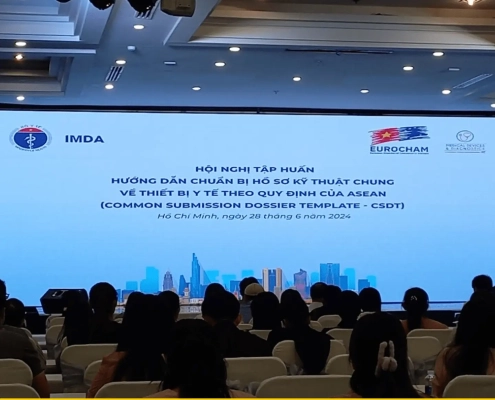Come grow with us in the US in Thailand in China in Korea in the Philippines in Taiwan in Hong Kong
Sign Up For Our Newsletter to Stay Informed
What is the Common Submission Dossier Template (CSDT) and How to Use it
Published on: July 20th, 2022
Harmonizing Application Requirements in Southeast Asia
Manufacturers looking to Southeast Asia to help grow their medical device sales should become familiar with the Common Submission Dossier Template, or “CSDT.” The CSDT is the application standard developed under the ASEAN Medical Devices Directive (ASEAN MDD), meant to help harmonize the regulatory requirements in the region. By harmonizing the documentation, ASEAN member countries reduce the burden to entry for foreign manufacturers by limiting the alterations needed prior to application submission. CSDT is similar to the documentation submitted for a US 510(k) and CE Marking in Europe and will require chapters such as an executive summary, the essential principles to show conformity, device description, design verification, clinical data (CER), labeling, risk analysis, and manufacturer information.
The History of the ASEAN MDD and CSDT
The CSDT, or the Common Submission Dossier Template, was developed as part of the ASEAN MDD and has been implemented in member countries according to their own schedules. Singapore’s Health Science Authority (HSA) is seen as the gold standard in the region is often the “ASEAN Reference country” as they are typically first to implement, provide very clear guidance and regulations, and their approvals can sometimes be leveraged in other ASEAN markets for quick review times. Their CSDT guidance for non-IVDs can be found here (PDF) and IVD guidance can be found here (PDF).
Originally established as the Association of Southeast Asia (ASA) in 1961, the Association of Southeast Asian Nations (ASEAN) includes 10 countries and promotes intergovernmental cooperation and facilitates economic, political, security, military, educational, and sociocultural integration between its members and other countries in Asia. Member countries include Singapore, Malaysia, Thailand, Vietnam, Indonesia, the Philippines, Brunei, Cambodia, Myanmar, and Laos. At the time of publishing the Secretary General is Lim Jock Hoi as Brunei holds the chair for 2022. In 2008, ASEAN member countries met and agreed to move closer to “an EU-style community” but the relationship has not been established as intended with many countries remaining autonomous, implementing ASEAN policies at their own pace.
Implementation of CSDT Among ASEAN Member Countries
At this time, CSDT documentation is accepted in Singapore, Malaysia, Indonesia, the Philippines, Thailand, and will start being accepted in Vietnam in 2023 for Class C and D devices. It is also expected that competent authorities may establish new expedited reviews for products already approved with CSDT documentation in other ASEAN Member States. For example, the Philippines FDA has established an expedited review for applications submitted with the same documentation used for an approval in a member market. Thailand has also created a similar process but is only available for high-risk devices at this time though it is expected to expand to lower risk products in the future.
Below is a quick synopsis of how CSDT is used in each country and more information on the registration process in each country can be found by clicking on each country’s name:
- Singapore: CSDT format is required.
- Malaysia: CSDT format is required.
- Philippines: CSDT format is required. The PFDA will expedite review of CSDT documents approved by any other ASEAN member country that reviewed the exact same documentation i.e. Singapore, Malaysia, Thailand, Indonesia.
- Thailand: CSDT format is required. The TFDA will expedite the review of applications for products approved by Singapore’s HSA that used the exact same documentation.
- Indonesia: CSDT format is required.
- Vietnam: CSDT format is not currently required but the MOH is expected to implement CSDT format for Class C and D applications in 2023 or 2024.
CSDT Documentation Components
CSDT documentation is similar to other countries’ requirements and will require information on the product, clinical evidence, design verification, risk analysis, labeling, and manufacturing information. The ASEAN CSDT document contains elements of the Global Harmonization Task Force (GHTF) guidance document titled “Summary Technical Documentation for Demonstrating Conformity to the Essential Principles of Safety and Performance of Medical Devices (STED)” (Document number: SG1/N011R17), and the International Medical Device Regulators Forum (IMDRF) Non-In Vitro Diagnostic Device Market Authorization Table of Contents (nIVD MA ToC).
The following documents will be required as part of the CSDT application.
- Executive summary
- an overview, e.g., introductory descriptive information on the medical device, the intended purposes and indications for use of the medical device, any novel features and a synopsis of the content of the CSDT;
- commercial marketing history;
- intended purposes and indications in labelling;
- list of regulatory approval or marketing clearance obtained;
- status of any pending request for market clearance; and
- important safety/performance related information.
- Relevant Essential Principles and methods used to demonstrate conformity
- Device description
- Description and features
- Intended purpose
- Indications
- Instructions for use (IFU)
- Contraindications
- Warnings
- Precautions
- Potential adverse effects
- Alternative therapy
- Materials
- Other relevant specifications
- Other descriptive Information
- Summary of design verification and validation, such as appropriate to the complexity and risk class of the medical device:
- a listing of and conclusions drawn from published reports that concern the safety and performance of aspects of the medical device with reference to the Essential Principles;
- engineering tests;
- laboratory tests;
- biocompatibility tests;
- animal tests;
- simulated use;
- software validation.
- Preclinical and clinical data such as a Clinical Evaluation Report (CER)
- Software verification and validation studies, if applicable.
- Medical devices containing biological material, if applicable.
- Clinical evidence
- Can include use of existing bibliography
- Device labeling
- Samples of labeling
- Instructions for Use (IFU)
- Risk analysis
- Manufacturer information
- Manufacturing process
- ISO 13485 certification, etc.
What is the Difference Between STED and CSDT?
International manufacturers will typically need to submit application documentation similar to one of two primary formats: STED or CSDT. STED, which stands for Summary Technical Documentation, was originally developed in 2011 by the Global Harmonization Task Force (GHTF), now known as the IMDRF (International Medical Device Regulators Forum). STED has created the foundation for documentation required in the 5 major markets, also known as Reference Countries. “Reference Countries” is the nickname given to the 5 major medical device markets: US, Canada, Europe, Japan, and Australia. Approvals from one or more Reference Countries can significantly help manufacturers obtain quicker reviews in many secondary markets and are often crucial to the registration process. Reference country approvals can be often be leveraged due to them being seen as showing legitimate safety and efficacy oversight.
While STED and CSDT are similar when it comes to the overall topics of the documentation such as the Essential Principles, Risk Analysis, and manufacturing process, there are some minor differences manufacturers should pay attention to when compiling their documents.
Some of the differences include:
Local Language Requirements: CSDT documentation will require more information as many ASEAN Member countries have specific Instructions for Use (IFU) translation and labeling requirements that Reference Countries don’t usually require.
Executive Summary: The CSDT application will require an Executive Summary of the product and in some countries like Indonesia and Vietnam, may require this in the local language. While the format will differ, the evidence used in STED documentation will almost always suffice for CSDT and new evidence is rarely needed.
For a more complete understanding of the STED vs. CSDT requirements please click here (PDF) for the GHTF’s guidance and contact Asia Actual if you need support or have questions.
Come Grow With Us
Please contact us if you’d like support developing your CSDT documentation and/or understanding how to use it effectively. Asia Actual specializes in helping medical device manufacturers grow their sales in Asia with experienced, bi-lingual commercial and regulatory experts on the ground in each market. Contact Asia Actual today with any questions or support requests.
Asia Actual is a regulatory consulting company specializing in helping manufacturers grow their sales through independent license holding, direct fulfillment, and a variety of sales channel support services.






